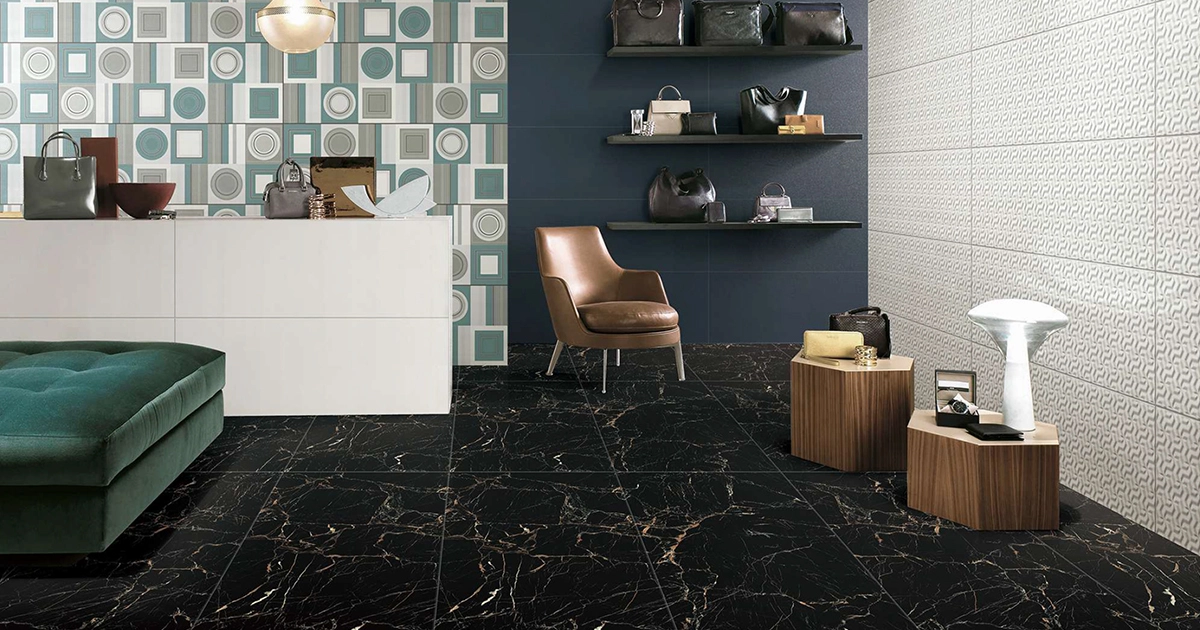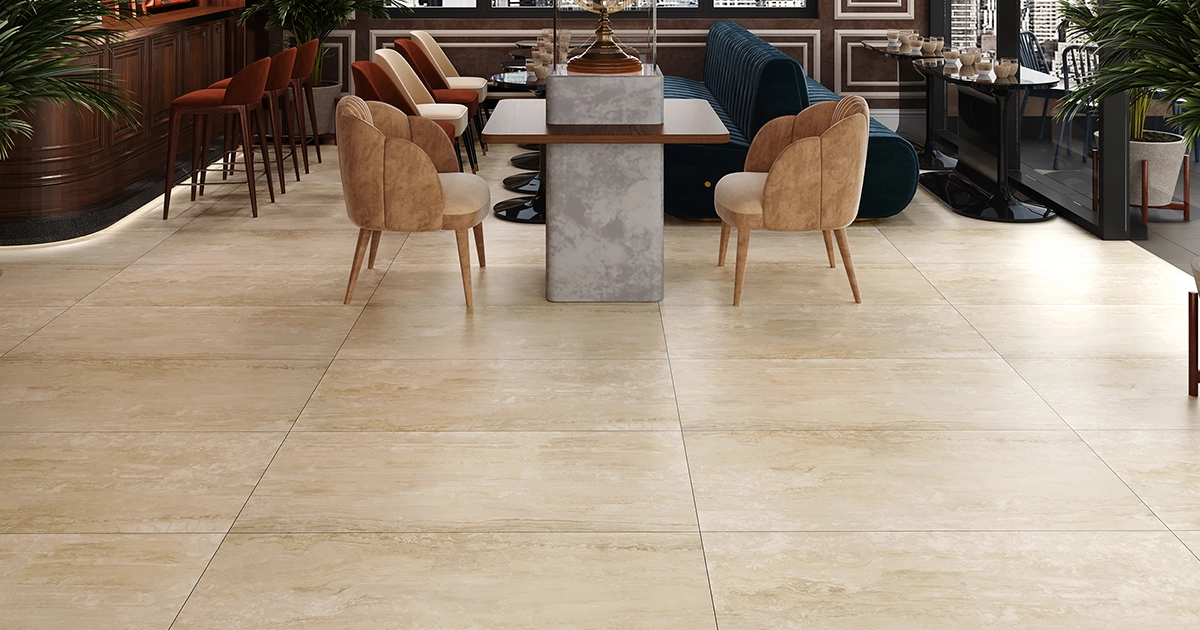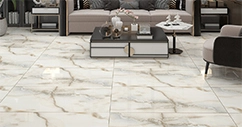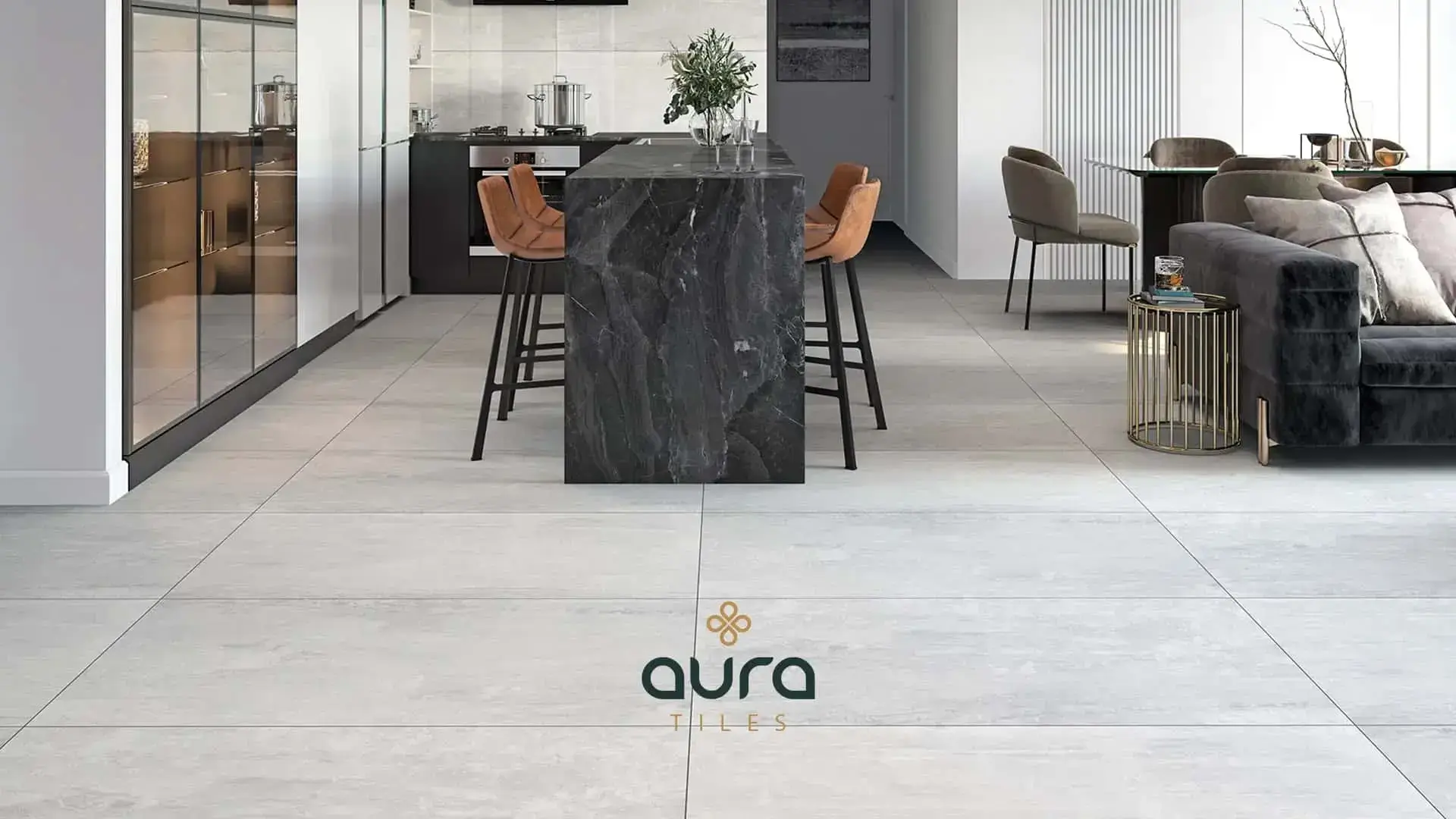Selecting the right flooring for your bathroom is an important decision for anyone who loves decorating their home. The two most popular tiling choices are porcelain or ceramic tiles, which are standard worldwide. When choosing between porcelain and ceramic tiles, the debate is always on performance, appearance, cost, and ease of installation. While both porcelain and ceramic tiles share a similar appearance and purpose, they have subtle differences that make one better suited for certain applications.
Some people also confuse porcelain and ceramic tiles to be similar in everything. In this blog, we’ll compare porcelain tile vs ceramic tile to help you make the best choice for your bathroom and kitchen.
What Is a Ceramic Tile?
A ceramic tile is one of the most commonly used tile in the home interiors and architecture industry. It is made from clay that has been shaped and then fired at high temperatures. It is a popular material for flooring, walls, countertops, and various other applications in both residential and commercial settings. Ceramic tiles are available in different forms, sizes, shades, and patterns. That is why these tiles are considered a customizable option for both interior and exterior designs. They are appreciated for their durability, easy maintenance, and resistance to moisture.
What Is a Porcelain Tile?
Porcelain tile is a specific type of ceramic tile that is made from finer and more purified clay than regular ceramic tiles. The manufacturing process for porcelain tiles involves higher temperatures and pressure, resulting in a denser and less porous product. Porcelain tiles are also used commonly because they can mimic the look of natural stone, wood, or other materials, providing versatile options for various design preferences.
Porcelain Tile vs Ceramic Tile: Main Differences
Some people confuse porcelain tiles to be the same as ceramic tiles. Porcelain tile and ceramic tile are both popular choices for flooring and wall coverings, but they have some key differences in terms of composition, density, water absorption, and suitability for various applications. Here is a breakdown of the main differences between porcelain and ceramic tiles:
| Property | Ceramic Tile | Porcelain Tile |
| Composition | Mixture of red, brown, and white clays | Mixture of finer and more purified clay, including feldspar and other minerals |
| Density | Less dense | High density due to a more refined clay and a higher firing temperature |
| Water Absorption | More porous, with higher water absorption rates (typically more than 0.5%) | Less porous, with lower water absorption rates (usually 0.5% or less) |
| Durability | Prone to chipping and cracking | Highly durable and resistant to wear and tear. |
| Suitability for Moist Areas | Unsuitable for high moisture areas, such as bathrooms or outdoor installations | Suitable for areas with high moisture levels |
| Cost | More Affordable | Expensive |
| Appearance | Versatile | Natural stone, wood, or other materials |
Which Tile Is Better for Kitchens: Porcelain or Ceramic?
Porcelain tiles are a better option for kitchen flooring and walls due to their high density, low water absorption, and exceptional durability. Their manufacturing process involving higher firing temperatures results in high resistance to moisture, scratches, and chipping, making them well-suited for a kitchen interior. While porcelain tiles may be a slightly more expensive option, their longevity and resistance to stains and water damage make them a practical choice for homeowners prioritizing durability and minimal maintenance.
On the other hand, ceramic tiles are a viable and cost-effective alternative for kitchens, particularly if the budget is limited. Although not as dense as porcelain, ceramic tiles offer a wide variety of designs and colors, allowing you to achieve the desired aesthetic for your kitchen. However, it’s important to note that ceramic tiles have a higher water absorption rate, requiring more diligent maintenance to prevent staining and damage from prolonged exposure to water.
Best Tile for Shower Walls: Ceramic Vs Porcelain
While choosing between ceramic and porcelain tiles for shower walls you should consider factors such as water resistance, durability, and budget considerations. As porcelain tiles are highly resistant to moisture and reduce the risk of water damage and mold in the shower area, they can be a better option for shower walls. However, ceramic tiles can be more budget-friendly. It’s important to select those with low water absorption and consider using glazes for added protection. Glazed tiles are however NOT recommended for bathroom floors as they are slippery and don’t offer much traction. Despite being slightly more porous than porcelain, well-maintained glazed ceramic tiles can still provide a cost-effective and visually appealing solution for shower walls.
Ultimately, the decision is based on your own priorities. Both options allow for aesthetic choices to complement the overall design of the bathroom.
Pros & Cons of Porcelain Tiles and Ceramic Tiles
Now the decision of choosing ceramic or porcelain tile depends on your preferences and need of use. But here is a quick pros and cons analysis of both types of tiles so you can better understand which of these tiles can be your ideal choice:
Pros of Porcelain Tiles
- Porcelain tiles have the quality of being highly durable and resistant to damage. They are suitable for high-traffic areas and heavy use.
- Porcelain tiles have low water absorption, making them highly resistant to moisture. This feature is advantageous in areas with high humidity or frequent exposure to water.
- The low porosity of porcelain tiles makes them resistant to stains, making maintenance easier.
- Porcelain tiles are also available in different range of styles, colors, and shapes. They can also have a look similar to that of natural stone, wood, or other materials.
- Due to their low water absorption, porcelain tiles are often used for outdoor applications, such as patios and walkways.
Cons of Porcelain Tiles
- Porcelain tiles are generally more expensive than ceramic tiles, making them a higher upfront investment.
- The density of porcelain tiles makes them heavier, which can be a consideration for certain installations.
- The hardness of porcelain tiles can make them more challenging to cut and install, requiring specialized tools.
Pros of Ceramic Tiles
- Ceramic tiles are often more budget-friendly than porcelain tiles, making them a cost-effective option for various projects.
- Ceramic tiles are lighter than porcelain tiles, making them easier to handle and install.
- Like porcelain, ceramic tiles come in a variety of designs, colors, and patterns, providing versatility in design choices.
- Ceramic tiles are generally easier to cut during installation, requiring less specialized equipment.
Cons of Ceramic Tiles
- Ceramic tiles have a higher water absorption rate compared to porcelain, making them less suitable for areas with high moisture levels.
- While durable, ceramic tiles may be more prone to chipping and scratching compared to porcelain.
- Due to their higher water absorption, ceramic tiles are not as suitable for outdoor applications as porcelain tiles.
Where to Get the Best Quality Porcelain and Ceramic Tiles?
Now that you are equipped with all the knowledge about which tile to choose between porcelain tile vs ceramic tile, you need to find the right place to purchase these tiles. Both tiles offer unique qualities and have their own pros over the other. You can get the highest quality original porcelain and ceramic tile from Aura tiles, at Hadayat & Co.’s showrooms in Pakistan. Hadayat & Co. has an excellent range of both imported and local tiles for floors and bathrooms. You can choose from various tile designs according to your home interior and match them with your wall paints.
Conclusion
Porcelain tiles stand out for their impressive durability, low water absorption, and suitability for high-traffic areas. While they may come with a higher initial cost, the investment pays off in the long run. On the other hand, ceramic tiles offer a budget-friendly option with a myriad of design choices, making them a versatile solution for various projects.
Whichever you choose, both porcelain and ceramic tiles bring style and functionality to your spaces, ensuring a flooring or wall covering that not only meets your practical needs but also reflects your unique aesthetic taste.
FAQs
Do Porcelain Tiles Chip Quickly?
No, porcelain tiles are known for their durability and resistance to chipping. They are less prone to damage compared to some other types of tiles.
Are Porcelain Tiles Cheaper Than Ceramic Tiles?
Generally, porcelain tiles are more expensive than ceramic tiles due to their higher manufacturing costs and enhanced properties such as lower water absorption and increased durability.





